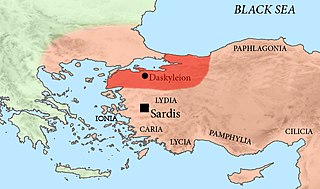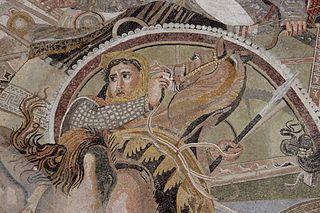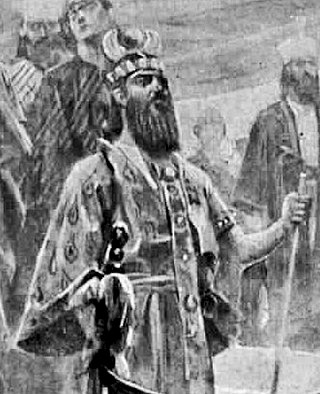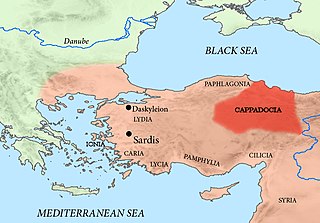Related Research Articles

The Battle of Issus occurred in southern Anatolia, on 5 November 333 BC between the Hellenic League led by Alexander the Great and the Achaemenid Empire, led by Darius III. It was the second great battle of Alexander's conquest of Asia, and the first encounter between Darius III and Alexander the Great. The battle resulted in the Macedonian troops defeating the Persian forces.

The Battle of Gaugamela, also called the Battle of Arbela, took place in 331 BC between the forces of the Army of Macedon under Alexander the Great and the Persian Army under King Darius III. It was the second and final battle between the two kings, and is considered to be the final blow to the Achaemenid Empire, resulting in its complete conquest by Alexander.

Calas or Callas was an ancient Greek, son of Harpalus of Elimiotis and first cousin to Antigonus, king of Asia.

Oxyathres was a brother of the Persian king Darius III Codomannus. He was the son of a certain Arsames, and grandson of Ostanes. He was distinguished for his bravery, and in the battle of Issus, 333 BC, took a prominent part in the combat in defence of the king, when attacked by the Macedonian cavalry under Alexander himself, as shown in the celebrated Alexander Mosaic found in Pompeii. He afterwards accompanied Darius on his flight into Bactria, and fell into the hands of Alexander during the pursuit, but was treated with the utmost distinction by the conqueror, who even assigned him an honourable post about his own person; and subsequently devolved upon him the task of punishing Bessus for the murder of Darius. He was also the father of Amastris queen of Heraclea.

Balakros, also Balacrus, the son of Nicanor, one of Alexander the Great's "Somatophylakes" (bodyguards), was appointed satrap of Cilicia after the Battle of Issus, 333 BC. He succeeded to the last Achaemenid satrap of Cilicia, Arsames.

Satibarzanes, a Persian, was satrap of Aria under Darius III, king of Persia.
Caranus, a Macedonian member of the elite cavalry body known as the hetairoi (Greek:ἑταῖροι), was one of the generals sent by Alexander the Great against Satibarzanes when, for a second time, he had encouraged Aria to revolt. Caranus and his colleagues were successful in achieving their objective by defeating and slaying Satibarzanes in the winter of 330 BC.
Stasanor was a native of Soli in Cyprus, who held a distinguished position among the officers of Alexander the Great.
Phrataphernes was a Persian who held the government of Parthia and Hyrcania, under the king Darius III Codomannus, and joined that monarch with the contingents from the provinces subject to his rule, shortly before the battle of Gaugamela in 331 BC. He afterwards accompanied the king on his flight into Hyrcania.

Oxyartes was a Sogdian or Bactrian nobleman of Bactria, father of Roxana, the wife of Alexander of Macedon.

Artabazos II was a Persian general and satrap of Hellespontine Phrygia. He was the son of the Persian satrap of Hellespontine Phrygia Pharnabazus II, and younger kinsman of Ariobarzanes of Phrygia who revolted against Artaxerxes III around 356 BC. His first wife was an unnamed Greek woman from Rhodes, sister of the two mercenaries Mentor of Rhodes and Memnon of Rhodes. Towards the end of his life, he became satrap of Bactria for Alexander the Great.

Barsine was the daughter of a Persian father, Artabazus, satrap of Hellespontine Phrygia, and a Greek Rhodian mother, the sister of mercenaries Mentor of Rhodes and Memnon of Rhodes. Barsine became the wife of her uncle Mentor, and after his death married her second uncle, Memnon.

The Partition of Babylon was the first of the conferences and ensuing agreements that divided the territories of Alexander the Great. It was held at Babylon in June 323 BC. Alexander’s death at the age of 32 had left an empire that stretched from Greece all the way to India. The issue of succession resulted from the claims of the various supporters of Philip Arrhidaeus, and the as-of-then unborn child of Alexander and Roxana, among others. The settlement saw Arrhidaeus and Alexander’s child designated as joint kings with Perdiccas serving as regent. The territories of the empire became satrapies divided between the senior officers of the Macedonian army and some local governors and rulers. The partition was solidified at the further agreements at Triparadisus and Persepolis over the following years and began the series of conflicts that comprise the Wars of the Diadochi.

The Battle of the Persian Gate took place as part of the Wars of Alexander the Great. In the winter of 330 BC, Ariobarzanes of Persis led a last stand with his outnumbered Persian army at the Persian Gate, near Persepolis, and held back the Macedonian army for approximately a month. However, through captured prisoners of war or a local shepherd, Alexander found a path around to flank the Persian troops from the rear, allowing him to capture half of Persia proper in another decisive victory against the Achaemenid Empire.
Arsames was an Achaemenid Persian satrap of Cilicia in 334/3 BC. He succeeded Mazaeus in this position. He took part in the Battle of Granicus where he fought with his cavalry on the left wing, along with Arsites and Memnon of Rhodes. He was able to survive that battle and flee to the capital of Cilicia Tarsus. There he was planning a scorched-earth policy according to that of Memnon which caused the native Cilician soldiers to abandon their posts. He also decided to burn Tarsus to the ground so as not to fall in the hands of Alexander but was prevented from doing so by the speedy arrival of Parmenion with the light armored units who took the city. After that, Arsames fled to Darius who was at this time in Syria. He was slain at the battle of Issus in 333 BC.

Orontes II was a Persian noble living in the 4th century BC. He is probably to be identified as the satrap of Armenia under Darius III, and may in fact have succeeded Darius in this position when Darius ascended the throne of Persia in 336 BC.

Sabaces was an Achaemenid Persian satrap of the Achaemenid Thirty-first Dynasty of Egypt during the reign of king Darius III of Persia.

Mithrobuzanes was a Persian governor (satrap) of Cappadocia in the 4th century BC, during the reign of Darius III. He was probably a son of Ariarathes. As a Persian military commander he was killed at the Battle of Granicus fighting Alexander the Great.

Arsites was Persian satrap of Hellespontine Phrygia in the Achaemenid Empire in the 4th century BC. His satrapy also included the region of Paphlagonia.
Rheomithres was a Persian noble. He was father of several children, including Phrasaortes whom Alexander the Great appointed satrap of Persis in 330 BC. He joined in the Great Satraps' Revolt of the western Persian provinces from Artaxerxes II, in 362 BC, and was employed by his confederates to go to Tachos, pharaoh of Egypt, for aid. He came back with 500 talents and 50 warships and he is supposed to have left his wife and his children to Tachos as a guarantee for his assistance. Nevertheless, Rheomithres betrayed the rebels and he invited a number of them in a meeting. On their arrival, he arrested them, and despatched them in chains to Artaxerxes to receive the bounties, thus making his own peace at court. Rheomithres took part in the battle of the Granicus, in 334 BC, where he was in command of a body of 2,000 cavalry on the right wing, between 1,000 Medes and 2,000 Bactrians. He survived the battle and the next year he joined Darius at the battle of Issus, where he lost his life.
